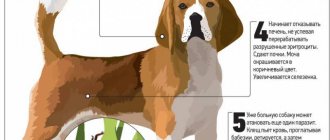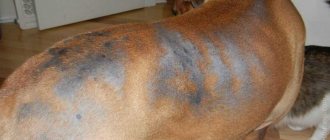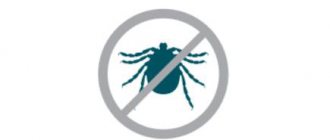Why do dogs develop allergies?
Most often, it is not a food allergy that is diagnosed, but the body’s reaction to dust, pollen, even bed mites. Dogs are often diagnosed with a severe allergic reaction to tick and flea bites. In these places, a rash, itching, and even hair loss may occur. The diagnosis of food allergy is extremely rare.
Why do dogs develop allergies?
- This is due to the fact that dogs are usually fed the same foods throughout their lives, so the occurrence of an allergic reaction, if it was not noticed before the age of 1 year, is extremely rarely diagnosed.
- Much more often, allergies occur due to non-food allergens. Dogs often suffer not from an allergic reaction at all, but from atopic dermatitis. The nature of this disease is not fully understood, but there are breeds that suffer from atopic dermatitis more often than others.
- These include cocker spaniels, boxer dachshunds, sharpeis, German shepherds and golden retrievers. It is these breeds that suffer from atopy and cross-allergy to foods.
Cute doggie
Allergies in dogs: symptoms
In order to diagnose a food allergy, a special diagnosis is carried out, which is called an elimination diet. At first, foods that are part of the dog’s usual diet are removed from the dog’s diet, and then they are gradually returned. After this, the dog’s owner looks at which product was administered when the relapse occurred. Most often, this diet is introduced with full confidence that the dog does not have fleas, scabies mites, and other pathogens that provoke severe itching and hair loss in certain places.
Allergies in dogs, symptoms:
- Allergies in four-legged friends manifest themselves in the same way as in people. Usually this is redness of the eyes, discharge of a large amount of mucus from the nose and mouth, rashes, redness, and severe itching.
- In general, the dog may feel quite unwell and may feel unwell. However, the temperature remains normal.
- Typically, allergy rashes appear on the face, ears, and in the folds of the skin, under the paws. Often redness and pimples appear in these areas, which the dog may scratch.
Cute dogs
How to determine food allergies in dogs?
Dogs often have food allergies, but they are not always food allergies. The fact is that food for doggies includes products that, in fact, should not be there. These could be preservatives, dyes, or some kind of flavoring additives or spices.
How to determine food allergies in dogs:
- If you notice that after purchasing a new food your dog has an allergy, then it must be excluded. The allergy does not develop instantly, but over 2 weeks. Therefore, after purchasing a new food, the next day there may be no allergy.
- In order to find out what product the dog is allergic to, it is necessary to completely change his diet, or rather introduce a new type of protein, replacing the old one. That is, if it was chicken before, then you need to replace it with duck or beef.
- For 5-8 weeks, you must adhere to this diet plan, completely eliminating chicken. After this, the dog is given chicken again for one or two weeks. After this, it is worth observing the results. If there really is an allergy to chicken protein, then the dog will again develop dermatitis and allergies.
Cute dog
Allergy to fleas in a dog
If you do not get any results from using the elimination diet, you have another type of allergic reaction. As stated above, food allergies in dogs are extremely rare. Therefore, the most common reaction is to flea bites.
Allergy to fleas in dogs:
- Exacerbations are diagnosed in spring and autumn. That is, after hibernation and before it, fleas’ appetite increases, they become more active, and jump on animals more willingly.
- It is necessary to put flea collars on dogs in the spring and autumn, and also bathe them with appropriate shampoos. After a while, if the allergy was caused by fleas, it will disappear.
- Why does flea allergy occur? The fact is that the saliva of these parasites contains a certain type of protein to which dogs can have an allergic reaction. At the site of the bite, redness, peeling, severe itching occurs, and the area may even swell.
- Therefore, in autumn and spring, during periods when fleas are very active, it is necessary to use special shampoos for bathing against fleas, and also use collars.
Pollen allergy
What to replace it with?
You can also use the following analogues of the drug Loratadine:
| Cyprodine | The drug is available in the form of tablets for oral administration. Good for hives, insect bites and serum sickness |
| Bicarfen | Used to treat several types of allergies. Recommended for rhinitis, lacrimation, dermatitis, neurodermatitis, drug and food reactions |
| Cetirizine | The product does not cause drowsiness. Given once or twice a day. |
| Astemizole | Effective for food allergies, urticaria and allergic rhinitis. Can only be given to adult dogs. |
| Ketotifen | Give for anaphylactic shock and histamine bronchospasm. Requires a course of treatment. |
| Tavegil | The medicinal effect is similar to that of diphenhydramine, but lasts longer |
| Suprastin | It is preferable to use a 2% solution. Suitable for all types of allergies |
| Diazolin | Prescribed for reactions of unknown origin. Available in the form of tablets for oral administration. Disadvantage: May adversely affect the central nervous system. |
| Diprazine | A drug that causes drowsiness. Used for severe itching. Also available in tablet form |
| Diphenhydramine | It is administered intramuscularly or subcutaneously. It is used for any reactive pain, including medicinal ones. |
What can you give your dog for allergies?
Before determining what your dog is allergic to, you should consult a doctor. If the owner suspects a food allergy, then it is necessary to use the food exclusion method. After this, the doctor examines for bites and evaluates the rash. In any case, it is necessary to exclude infection with scabies mites and other parasites to which an allergic reaction may occur. Oddly enough, but dogs most often develop allergies to flea bites, dust and pollen.
What can you give your dog for allergies:
- There should be no allergy to household dust and bed mites, so it is often classified as atopic dermatitis. Living with such animals is quite difficult, since it is necessary to get rid of all rugs and sources of dust.
- In addition, it is necessary to frequently clean the floor with a damp cloth to remove dust. This type of allergy is difficult to diagnose because it is almost impossible to determine what the dog is allergic to.
- The fact is that atopy is often mixed with food allergies, thereby creating a crossover. It is quite difficult to treat, so it is necessary to fully find out what caused the body’s reaction.
- Antihistamines are administered to treat an allergic reaction. However, in most cases, the main treatment for an allergic reaction is to eliminate contact with the allergen.
- That is, it is a kind of prevention, and at the same time treatment. Foods that cause an allergic reaction are simply excluded from the menu.
Dog itching
General signs of allergies
The allergy is not immediately noticed, since a common symptom for all types of such reactions is inflammation and redness of the skin, which is not easy to detect under the fur. The pet itself will not tell you about the itching, which also accompanies any allergy.
To detect the disease at an early stage, preventive examinations of the pet are carried out periodically. Choosing the right antihistamines for dogs is only possible with a careful analysis of the cause and type of allergy.
Varieties and pathogens
A large number of factors can provoke an allergic reaction.
The following types of allergies are distinguished:
- food;
- cutaneous;
- against pests;
- infectious.
1. Food allergies
Provokes the development of a reaction:
- poultry, beef;
- yeast;
- eggs;
- fish;
- soy products;
- vegetables and fruits with scarlet interior;
- wheat;
- dairy food;
- corn;
- vegetable oils and fish oil.
Allergens are also foods that are strictly prohibited from feeding a dog in principle: fried foods, smoked meats, spices, salt, sugar and chocolate.
Food allergies
Food allergies
Signs of food allergies:
- severe itching (the animal scratches areas of the body for a long time and furiously);
- redness, roughness and poor moisture of the skin;
- a pungent odor from the dog itself and from the open mouth (sometimes sores and sores can be seen on the gums and lips);
- sweating, which is not typical for a healthy dog (wet areas are found on the body);
- loss of clumps of hair and the appearance of baldness - bare areas (however, hair loss may indicate the presence of more serious diseases);
- white particles all over the body - dandruff - a clear sign;
- discharge from the ears (the pet shakes its head, scratches its ears);
- tearfulness.
2. Skin allergies
This type of disease occurs as a result of an atypical reaction of the dog’s immune system to external irritants and substances ingested.
The main factors contributing to the development of allergic dermatitis are:
- dust;
- synthetic fabrics (clothing, carpets);
- the fur of other pets or your own;
- medicines;
- household products or cosmetics;
- shampoo, soap;
- pollen.
The pet's body may react to the following groups of drugs: serums, vitamin B and its variations, amidopyrine, novocaine, antibiotics, barbiturates, sulfonamides. Some medications contain pollen, which can cause allergies.
A drug allergy will not reveal itself the first time it is used; it will occur when it enters the body again.
Sometimes after bathing with shampoo, your pet will show signs of allergic dermatitis. If allergies develop after using regular dog shampoos, you should use hypoallergenic ones.
You cannot bathe an animal using human care products.
A reaction to powder products occurs if the bedding is washed using them. Often your pet reacts to the odors of household chemicals, which causes swelling of the eyes and mouth. When external interaction with irritants occurs, itching and irritation appear.
Skin allergies
Basically, the symptoms of allergy varieties are similar, but the manifestations of the reaction on the skin have their own characteristic features:
- itching of a certain part of the body (for example, the dog scratches its ears or belly intensely);
- a lot of dandruff;
- disappearance of itching only as a result of the use of antihistamines.
If a reaction to the medicine occurs, disruptions in the functioning of the intestines occur; in difficult situations - swelling of the mucous membranes of the tongue, larynx and suffocation, anaphylactic shock, Quincke's edema. If a dog's body overreacts to a drug, a severe, overt, life-threatening allergy may develop that requires immediate medical attention.
3. Allergies to pests
After bites from ticks, fleas, mosquitoes, and bees, foreign proteins appear in the dog’s body, causing an allergic reaction. Rashes develop, itching appears and hair loss occurs. The symptoms can cause discomfort for the animal for a long time.
4. Infectious allergies
The body reacts to fungi, viruses, bacteria and helminths. The symptoms of worms and their photos were described earlier.
Allergy ointment for dogs
Most often, food allergies appear between the ages of 10 months and 3 years. It is during these time intervals that the first symptoms may appear. They can be diagnosed in puppies up to 1 year of age, then they outgrow them, the allergic reaction disappears for a while, but then appears again. An allergic reaction to shampoos or perfumes used by the owner may occur. It is quite difficult to determine, so the dog still suffers from allergies. The main treatment in this case is the use of antihistamines.
Allergy ointment for dogs:
- What to put on your dog for allergies? The fact is that this approach is fundamentally wrong, since it only allows you to get rid of the symptoms of the rash. The dog may still have nasal congestion, watery eyes, and various manifestations of allergies.
- By using topical ointments, just the rash may disappear. Among them, the most popular are glucocorticosteroids and antihistamines, for example, Fenistil.
- You can also use Trimistin, Prednisolone. These are products with glucocorticosteroids that quickly relieve itching.
Cute puppy
Preparations for dogs of small breeds and adults
Antihistamines are used to relieve allergy attacks. Second- and third-generation medications, as well as the first-generation drug Diazolin, are the optimal antihistamines for small breed dogs, such as Yorkies. They will reduce the possibility of side effects such as urinary problems, changes in heart function, and anxiety.
Second and third generation medications are more advanced than the first and are considered relatively safe drugs that have been used for a long time.
Antihistamines for dogs - the list for adults is headed by Suprastin, which stops the development of symptoms.
Also used are products originally intended for people: Diphenhydramine, Tavegil and others. When affecting an animal, antihistamines for dogs do not always produce the desired effect; sometimes they cause side effects, so it is highly advisable to seek advice from a veterinarian.
Antihistamines for dogs: the dosage depends on the weight of the pet and is calculated per kilogram.
How long does it take to treat allergies in dogs?
For complete treatment, it is necessary to rid the dog of allergens. That is, simply limit her contact with the product that causes a negative reaction. The duration of treatment will depend on how quickly you remove the allergen.
How long does it take to treat allergies in dogs?
- Therefore, if a dog once develops an allergy to chicken meat, it must be completely excluded from the menu. If the dog is kept on food, it is necessary to purchase a hypoallergenic option.
- There is food that does not contain allergenic proteins. It is made from veal, duck and turkey. After all, the most allergenic products are chicken protein, egg yolk, and fermented milk products.
- Hypoallergenic food does not contain these components. Take care of your vitamin intake. Often skin diseases are caused by vitamin deficiency or improper bowel function. Atopic dermatitis is not only allergic in nature, but depends on the condition of the gastrointestinal tract.
Manifestations of allergies
What can you give your dog for allergic itching: list of medications
Almost the same antihistamines are used as in humans, the dosage is different.
What can you give your dog for allergic itching, list of medications:
- Diazolin. This is a second generation drug, it is not the best option, it is used mainly among toy breeds, as well as in mature individuals. It must be given according to the dosage indicated for children.
- Suprastin . This is one of the most inexpensive remedies that begins to work 30 minutes after administration. Can be given as an injection or given in tablets. On average, 2 mg is enough per 1 kg of weight. This is the maximum dose that can be taken per day.
- Diphenhydramine. This drug did not work very well, since it is useless to give it for acute manifestations of allergies. It is usually administered as a prophylaxis during vaccination.
- Tavegil. Often practiced by veterinarians, it is well suited for dogs of large weight. One tablet per day is enough for a dog that weighs 60 kg. If the pet is a little smaller, the tablet is simply divided into parts.
- Desloratadine . It is a derivative of loratadine, but an improved version of it. Therefore, the drug is more effective and has fewer contraindications than loratadine.
- Fenkarol . The drug is often used in veterinary medicine, but if the dog has diseases of the cardiovascular system, then the drug should be replaced with another.
The pet is sick
Many owners are surprised when their dog is allergic to chicken or eggs, foods that were part of the dog’s daily diet. Indeed, this happens, the body malfunctions, and reactions may occur that were not observed before.
Local treatment
When you detect the first signs of an allergy, you can begin to treat the dog on your own. For this, ointments with anti-inflammatory and antibacterial components are usually used. If your pet has itching in certain areas of the skin, various moisturizing lotions, mousses, ointments, creams or gels for dogs are usually prescribed. The main rule of local treatment: the ointment is applied to problem areas 2 times a day until the inflammation decreases.
Special shampoos and conditioners for dogs with the antibacterial components triclosan and chlorhexidine have a great effect. Regular washing of the animal will eliminate allergens from the fur and skin surface and thereby suppress the active development of bacteria.










